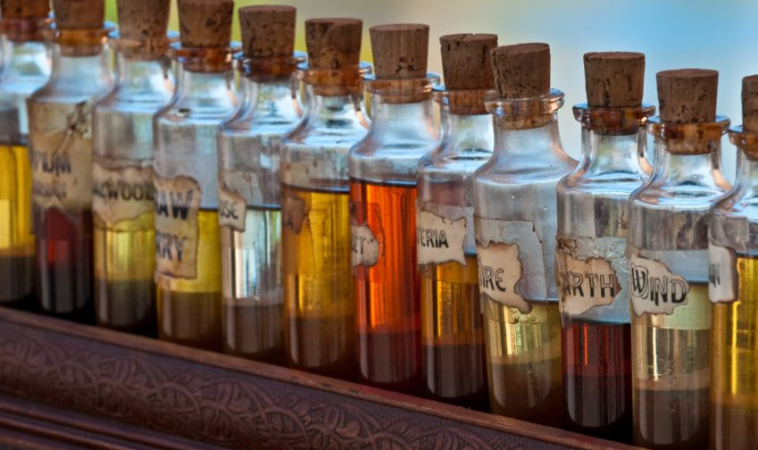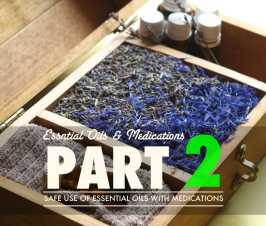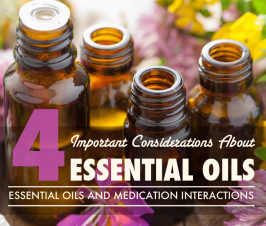Dr. Sarah LoBisco, ND
@DrLoBisco
There are a lot of conflicting opinions on essential oil safety. Here, I review some of the main reasons for the controversy and discuss the safety of using quality and standardized essential oils.
The Factors In Safety of Oils
Quality counts
One of the main reasons why there is so much conflicting evidence on safety of essential oils is because there is no standardization for purity in the United States. Any essential oil can be labeled as “100 pure”- as long as it contains a measly 5% of the essential oil. It can be filled with synthetics galore to the consumer’s ignorance; this can create many side effects due to the toxicity of some additives and chemicals.
So, for safety, make sure you are using quality genuine essential oils. I even suggest finding a company that moves beyond the label of “organic” and also accounts for standardization of the most active constituents.
A company should insure quality from “seed to seal” and the active constituents should be kept intact with proper distillation techniques, taking into account temperature and pressure as to not disrupt the action of the therapeutic compounds.
Here’s the cliff notes version of tests to look for from a reputable essential oil company. Third party verification and in-house testing would be optimal as well:
Tests for Quality Essential Oils
- Gas chromatography with GC/MS
- Heavy metals analysis
- Microbial analysis
- Flash Point
- Optical Rotation (Fake oil check)
- Refractive Index
- Specific Gravity
- Fourier transform infrared spectroscopy
Dose for size (of little bodies)
As with any herb or medication it’s dosage is just as important as selecting the correct remedy. Pediatric dosage should be applied for all little ones and never give a child the dose you would give an adult. Always dilute the oils with an organic carrier oil such as almond, coconut, olive oil when applying oils to sensitive skin or on children.
Essential oils are very concentrated and usually one drop is the therapeutic dose for adults. This means diluting the oil and using a carrier oil for someone 1/8 your size is paramount. Also, why would you want to waste your oils!
The different schools of aromatherapy…
Aromatherapists have diverse credentials and follow different forms of applications. The different schools do not agree on safety or application and as a result of this the migraine-producing differing opinions on Dr. Google transpire. Furthermore, they aren’t all using the same standardized or quality oils.
The National Cancer Institute reports:
Practitioners of aromatherapy apply essential oils using several different methods, including (1) indirect inhalation via a room diffuser or drops of oil placed near the patient (e.g., on a tissue), (2) direct inhalation used in an individual inhaler (e.g., a few drops of essential oil floated on top of hot water to aid a sinus headache), or (3) aromatherapy massage, which is the application to the body of essential oils diluted in a carrier oil.
…Training and certification in aromatherapy for lay practitioners is available at several schools throughout the United States and United Kingdom, but there is no professional standardization in the United States, and no license is required to practice in either country. Thus, there is little consistency in the specific treatments used for specific illnesses among practitioners. This lack of standardization has led to poor consistency in research on the effects of aromatherapy, because anecdotal evidence alone or previous experience has driven the choice of oils, and different researchers often choose different oils when studying the same applications. However, there are now specific courses for licensed health professionals that give nursing or continuing medical education contact hours, including a small research component and information on evaluating/measuring outcomes.1
A Critical Look At Toxicity Reports
Recently, I read an article online that would have even scared me if I didn’t have knowledge on how to accurately assess peer-reviewed journals.
After reading the actual studies from the article, this is what I found regarding the three incidents they reported:
- After swallowing almost a full bottle (10ml) of a commercial product of tea tree oil, a boy was brought to the hospital. The article indicated the boy was in critical condition, but in reality, the boy had NO symptoms after 5 hours. The article states:
A 23-month-old boy became confused and was unable to walk thirty minutes after ingesting less than 10 mL of T36-C7, a commercial product containing 100% melaleuca oil.The child was referred to a nearby hospital. His condition improved and he was asymptomatic within 5 hours of ingestion. He was discharged to home the following day. 2
- Another imbibing-happy incident of 41 little ones who swallowed 30 ml of eucalyptus, which is two full bottles of a typical 15ml essential oil (the equivalent of 350-750 servings). Thirty-three were asymptomatic and of the four children who ingested over 350 serving, two of the children exhibited NO symptoms and the other two had no lasting effects. The author concluded, “Eucalyptus oil may be a less toxic compound than has previously been believed.”3
- Evaluation of Essential Oil Massage on Childhood Eczema
In a study with possible contact dermatitis from repeated use, a strange combination of essential oils, including benzoin and “spike” lavender (compare this to lavendula angustifolia) was used, which biases the study results. 4
Let’s keep it in context
A recent review article collected 71 cases of patients of aromatherapy experiencing adverse effects up to date. There was only one fatality and adverse effects couldn’t be confirmed to be related to pure, standardized essential oils. 5
Compare those cases to reports from adverse effects in pharmaceuticals. According to the Center for Disease Control (CDC):
Deaths from drug overdose have been rising steadily over the past two decades and have become the leading cause of injury death in the United States.1 Every day in the United States, 114 people die as a result of drug overdose1, and another 6,748 are treated in emergency departments (ED) for the misuse or abuse of drugs.2 Nearly 9 out of 10 poisoning deaths are caused by drugs.6
Not So Common Sense Caveats on Safety & Quality Reports
With all the conflicting information on any health topic, including essential oils, it’s important to keep in mind several things for assessing the validity of the information. Here are some helpful tips to consider when determining the truth of any article, including mine:
- check for the references for peer-reviewed studies, if the author is only citing one source reference with different links, be weary they are only looking at one side of the equation
- check who funded the study for biases and conflicts of interest
- try to read the full abstract to see if conclusions match the author’s opinion
References:
- National Cancer Institute – PDQ Cancer Information Summaries. Aromatherapy and Essential Oils (PDQ®) Health Professional Version. Last Update: October 16, 2012. Available at: http://www.ncbi.nlm.nih.gov/pubmedhealth/PMH0032645/
- Jacobs MR, Hornfeldt CS. Melaleuca oil poisoning. J Toxicol Clin Toxicol.1994;32(4):461-4. Available at: http://www.poison.org/poisonpost/winter2010/teatreeoil.htm
- Webb NJ, Pitt WR. Eucalyptus oil poisoning in childhood: 41 cases in south-east Queensland. J Paediatr Child Health. 1993 Oct;29(5):368-71.
- Anderson C1, Lis-Balchin M, Kirk-Smith M. Evaluation of massage with essential oils on childhood atopic eczema. Phytother Res. 2000 Sep;14(6):452-6.
- Stea S, Beraudi A, De Pasquale D. Essential Oils for Complementary Treatment of Surgical Patients: State of the Art. Review Article. Evidence-Based Complementary and Alternative Medicine. 2014.
- CDC. Prescription Drug Overdose in the United States: Fact Sheet. CDC website. October 17, 2014. Available at: http://www.cdc.gov/homeandrecreationalsafety/overdose/facts.html
















